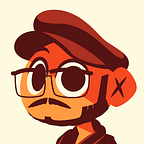As a language has dialects, Illustration and drawing have “styles” with particular traits. Cartoon style is all about economy. Cartoons are born out of the necessity of drawing and communicating more using less materials and time; thus, their perfect fit for animation.
We can think about cartoons as a really elaborated game of references. They allow the viewer to participate in the process of completing and decoding what they’re seeing, making them an active part of the process of consuming visual information, an interactive experience.
Good cartoon aesthetics could be argued to rely mainly upon the following:
- Simplification.
- Abstraction (or stylization).
- Exaggeration
- The development of a Distinctive Silhouette.
Simplification
Shortly: simplicity refers to a state of uncomplication. Something simple has few elements, or we could say: just the necessary elements to accomplish what it means to do, resulting in clarity and efficiency. Good cartoons are meant to be simple and clear while still fulfilling their expressive purposes.
To make our drawings simpler we just need to focus on our expressive intention and remove from our design all the elements that are redundant or not necessary to communicate our message. The most memorable cartoon character designs are those that are easy to memorize and reproduce.
Abstraction (or stylization)
Abstracting is generalizing, stating the value of expression over the portrayal of reality. Visually abstracting something is distilling an element into basic and easier to understand shapes, colors, and lines.
To apply abstraction to our cartoon drawing is easy, yet tricky. It is a highly intuitive process. We need to take the reference elements we’re drawing from and convert them into simpler shapes, colors, and lines without losing the representation of the original referenced element.
Exaggeration
Exaggerating is overstating something beyond the boundaries of what’s considered “truthful” or “normal”. As cartoons rely on using just the necessary elements and their abstraction to emphasize expression, exaggerating turns into a really useful resource to maximize the amount of information that is conveyed within those limits.
To apply exaggeration to our cartoons we need to analyze we need to emphasize the size in/or contrast in particular elements to send our message across with the right intensity, reinforcing or overstating what we want to say.
A distinctive silhouette
Our human brain has a particular property: it recognizes patterns and silhouettes before details. It prefers to memorize and make quick sense out of groups and sets of elements by their overall shape. Tahts the raeson why we can sitll unsdtarnd tihs, our brain is putting context and shape before the details. Thus, easy to read silhouettes help to make distinctive, memorable and recognizable cartoons.
To give our cartoons distinctive silhouettes our main help will be to use basic shapes as the overall base of the designs (the fewer the better), and at the same time, understand how those shapes communicate emotions that state our intention, but the language of the shapes is material for another post.
Great examples of stylization and simplification can be seen in children’s literature. I recently discovered the works of Alice and Martin Provensen their illustrations are sublime, with highly stylized figures and a superb application of good composition and color management. Regarding exaggeration; the work that John K (setting aside the controversy on him) did on Ren & Stimpy was profoundly impactful on me as a child. Finally, the best example I can think of (and that’s my personal opinion) is the one that Genndy Tartakovsky did on Dexter’s Lab, Samurai Jack and The PowerPuff Girls.
Good cartoons are more about good composition, simplicity and clever moves than rendering techniques; so practicing our fundamentals we can get pretty far away :)
If you have any thoughts, opinions or will like to consult me at something you can DM on twitter at @manuelberbin or email me at hola@manbe.me, if you got here and want to know a little more about me:
My name is Manuel Berbin, you can call me Manbe for short. I specialize in 2d vector cartoon illustration and concept development. I’ve been drawing cartoons my whole life and illustrating professionally at digital media for over 9 years. I was born in Venezuela but I’m currently living in Buenos Aires, Argentina.
If you want to see my 2D illustration work, you can check:
For quick recaps of this articles on presentation formats you can check my Instagram account:
